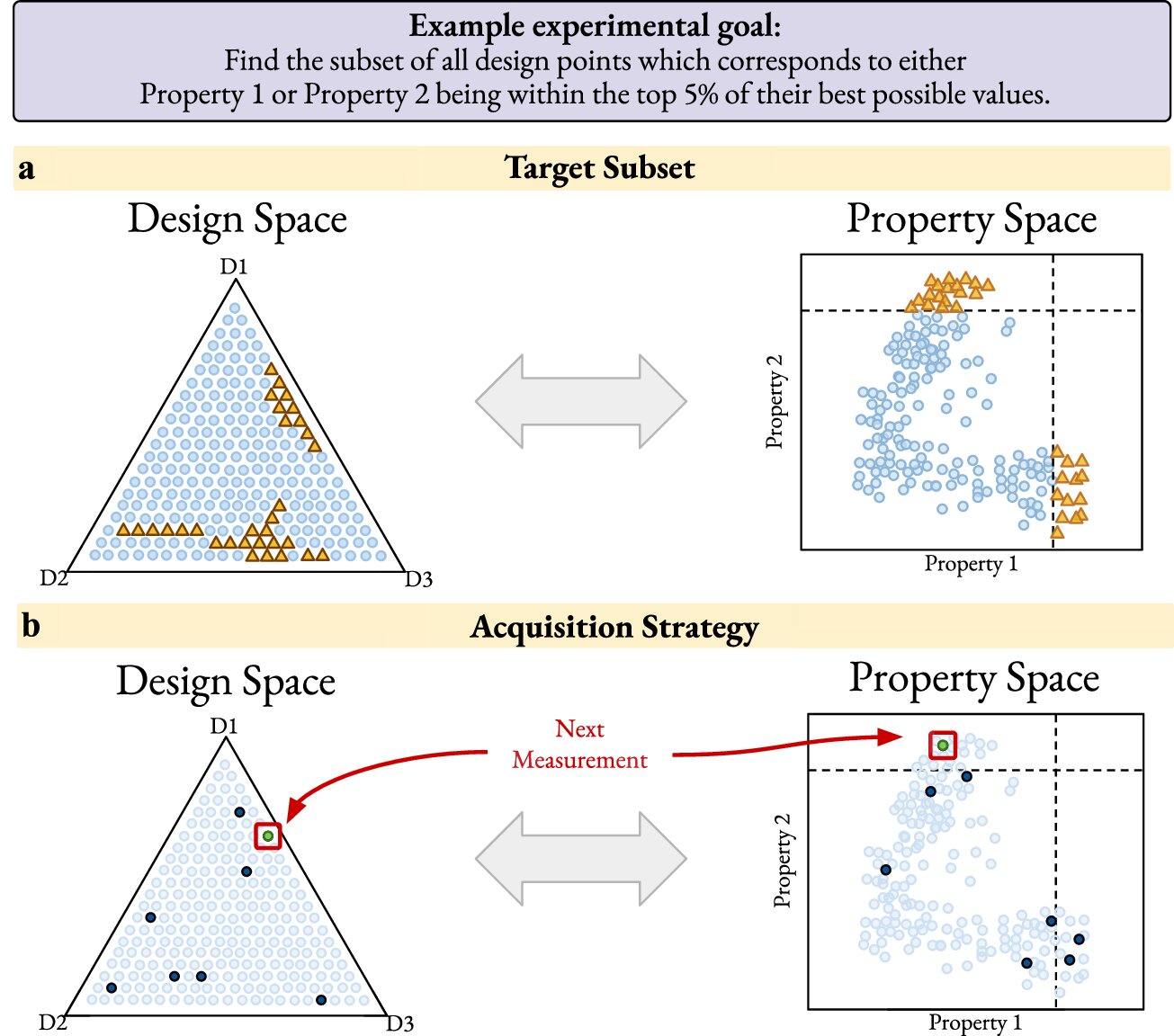Specification of an exemplary experimental objective and conversion to an automated data collection strategy. a Visualization of the design space and the corresponding measured property space for an example material system. Samples from the design space (discrete set of design points) are mapped directly to a set of measured properties (measured property space). The set of all possible design points and measurable properties are shown in blue. The target ground truth subset of the design space corresponding to the user target is shown in orange. Importantly, the subset of ground truth that achieves the experimental goal is unknown prior to the experiment. b The next data point is intelligently obtained based on both previously collected measurements and the specific experimental objective. The method for achieving this recommended strategy is the focus of the manuscript. credit: npj computing materials (2024). DOI: 10.1038/s41524-024-01326-2
Scientists have developed an artificial intelligence-based method that helps more efficiently collect data in the search for new materials, allowing researchers to tackle complex design challenges with greater precision and speed.
This research originated from a collaboration between computer science and materials science researchers at the Department of Energy’s SLAC National Accelerator Laboratory and Stanford University. The collaboration combines expertise in algorithm development, machine learning and materials science.
Their work, published today in npj computing materials, lays the groundwork for “self-driving experiments,” in which an intelligent algorithm defines the parameters for the next set of measurements at facilities such as SLAC’s Linac Coherent Light Source (LCLS). The new method also enables the rapid discovery of new materials that may hold promise in areas such as climate change, quantum computing and drug design.
Discovery of traditional materials has historically been a time-consuming and expensive process due to the costs of both manufacturing and measuring the properties of new materials. The space of possible materials is also extremely large, exceeding 10 billion material possibilities with just four elements. For pharmaceutical applications, the challenge is even greater – by a factor of 1060 possible drug-like molecules containing only the most basic building blocks (C, H, O, N and S atoms).
The task is further complicated by the need to satisfy complex design goals, such as discovering conditions for synthesizing nanoparticles of different sizes, shapes, and compositions. Traditional methods, which typically maximize or minimize a simple property, are often too slow to sift through huge search spaces to discover new materials that meet the researcher’s goals.
This paper proposes a new approach that takes complex objectives and automatically converts them into intelligent data collection strategies. A key feature is the ability to learn and improve from each experiment, using AI to suggest next steps based on the data collected so far. The innovation is based on the Bayesian Algorithm Execution (BAX) concept recently developed by co-author Willie Neiswanger, who was a postdoctoral fellow in computer science at Stanford at the time the study was conducted. In this method, a complex goal can be written as a simple shopping list or recipe, excellent in situations where multiple physical properties must be considered.
Another important aspect is that this method is easy to use and open source, allowing scientists from all over the world to use and adapt it for their research, promoting collaboration and innovation worldwide.
The researchers tested their approach on various custom targets for nanomaterial synthesis and magnetic material characterization. The results show that their methods are significantly more efficient than current techniques, especially in complex scenarios.
“Our method allows you to set complex goals, enabling automatic optimization in a large design space, which increases the probability of finding new, amazing materials,” said Satya Chituri, Ph.D. student at SLAC and Stanford who led the research. “The Bayesian Algorithm Execution Framework allows you to capture the intricacies of material design tasks in an elegant and simple way.”
The ability to design materials with specific catalytic properties, for example, can improve chemical processes that lead to more efficient and sustainable ways to produce goods and materials, reducing energy use and waste. In manufacturing, new materials could improve processes such as 3D printing, enabling more precise and sustainable production. In healthcare, personalized drug delivery systems can improve the targeting and release of therapeutics, increasing efficacy and reducing side effects.
Researchers are already implementing ways to integrate this framework into experimental and simulation-based research designs to demonstrate its broad applicability and effectiveness.
“The project is a great example of multidisciplinary collaboration between SLAC and Stanford,” said fellow Daniel Ratner, head of SLAC’s Machine Learning Initiative (MLI). “Satya was able to adapt Wiley’s fundamental algorithmic computational science research to address real scientific problems in materials science.”
MLI researchers are now looking for applications in large-scale materials simulations, and Neiswanger, Ratner and collaborators have just published a related application of BAX to optimize the performance of particle accelerators.
“By combining advanced algorithms with targeted experimental strategies, our method makes the process of discovering new materials easier and faster,” said collaborator Chris Tasson, director of the Materials Science Division for the Stanford Synchrotron Light Source (SSRL). at SLAC. “This could lead to new innovations and applications in many industries.”
More info:
Sathya R. Chitturi et al, Detecting target materials by running a Bayesian algorithm, npj computing materials (2024). DOI: 10.1038/s41524-024-01326-2
Courtesy of SLAC National Accelerator Laboratory
Quote: New AI Approach Speeds Discovery of Targeted Materials and Kicks Off Self-Driving Experiments (2024, July 18), Retrieved July 19, 2024, from https://phys.org/news/2024-07-ai- approach-materials-discovery-stage.html
This document is subject to copyright. Except for any fair dealing for the purposes of private study or research, no part may be reproduced without written permission. The content is provided for informational purposes only.



